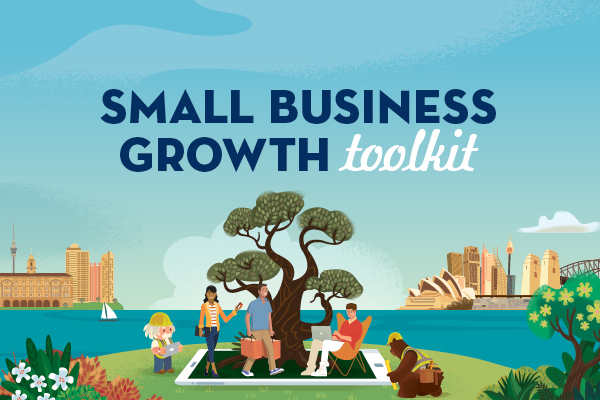Preparing to take your small business to the next level can be incredibly exciting. The future seems full of potential, the possibilities endless.
That bright future, however, suddenly feels uncertain. In a matter of weeks, best laid plans for business growth were tested as small business leaders sprung into action to rethink their business models and adapt to a changing world.
Yes, growing a business is always going to be challenging. But recent events and lockdown restrictions have given those challenges a whole new weight and complexity. Fortunately, small business leaders don’t have to rise to them alone. We have updated our Small Business Growth Toolkit with tips and expert insights to help you clear your path to business growth and stay on it, no matter how challenging it gets.
Preparation and business alignment: language matters
To grow successfully, you need a clear understanding of the company you want to become and how to get there.
At Salesforce, we map that path with a strategic alignment process called V2MOM which stands for:
- Vision — what do you want to achieve?
- Values — what’s important to you?
- Methods — how do you get it?
- Obstacles — what’s stopping you?
- Measures — how do you know when you have it?
It has become almost second nature to how we envision our goals and the methods for achieving them at scale. We believe success depends on constant communication and complete alignment, and this has been true since the day the first Salesforce V2MOM was developed. And it’s an approach and process that encourages creativity, change and empowerment to allow everyone to make a contribution. Whether your business uses V2MOM or some other strategy, the point is, you need a tool that helps create alignment in your organisation.
With an agreed upon framework, you have a language that everyone understands. And language and consistency matter hugely when you are asking your employees to go on this journey with you to grow your business. Take the word “vision”, for instance. You want to create and communicate a vision that is crystal clear to everyone so they can understand their role in achieving that vision.
Is it really customer first?
The customer always comes first — we hear it and say it all the time. But where does that leave your employees? Customer experience (CX) is often talked about as the most important thing for any business, but it’s especially important for small businesses that don’t have the luxury of deep pockets to invest in mass marketing. It is true that focusing on the customer has value, but so does focusing on your employees. Put your employees first, make sure they have what they need to be effective at their job and serve your customers. This is where using the right language can be so empowering.
Try this instead: Our company is employees first and customer-centric. It’s a subtle shift, but an important one that embraces employees and customers equally.
Aligning on language is critical to setting goals and being clear about how you’re going to measure and achieve them. However without a process, a framework, or a tool to help you consistently plan and communicate, you will find yourself playing catch up. And whatever tool you use to do that, it’s worth revisiting it several times a year, especially in the current climate.
Embracing technology, the right way
Digital technologies can be extraordinarily powerful. It’s hard to imagine getting through a global pandemic and subsequent lockdown without them, right? Our Growth Toolkit is a great resource to help you figure out which tools are right for your business today and tomorrow.
However, let me be clear, embracing technology is one thing, having the right people and processes in place to take advantage of that technology is another. Without the right mindset, technology alone won’t help much. You can’t just bolt on a bit of technology and expect it to fix everything that might be holding you back from growing. You need to make sure your people are trained and empowered to use it effectively. You must ensure you have the right metrics in place so they want to use it, not feel like they have to. Because the moment they can see the positive impact it’s having on their ability to do their job and serve the customers, that’s the moment you can start using technology to grow.
Why small businesses should invest in technology
I see many small businesses really grapple with this every day: invest or not invest in technology, and what are the implications of those choices? The thing is, small businesses are in a unique position to use technologies to outperform their larger competitors. Big businesses tend to be more siloed and have legacy systems slowing things down, not to mention larger numbers of people to train and support. Startups and growing businesses, on the other hand, can deploy the right technology correctly from day one.
However, small businesses can’t just enthusiastically take on new technologies before they’ve planned for them or even developed a mindset that will successfully accommodate them. They make the mistake of thinking they are too busy to fix something now and will come back to it later. It doesn’t work. “Later” usually means too late. And as Joshua Tabor, Chief Executive of Scouts New Zealand says in his Growth Toolkit tip, “Adding new technology to product-centric thinking won’t move you forward.”
New technologies have huge potential to help businesses grow, especially at times like this when online models are being rapidly embraced. But people and processes must be front and centre for those models to work. “Empowering your employees to adapt and grow with your business is as important as choosing the right technologies,” says Nick Holden, Founder and Director of Innovation of ModularWalls, in his contribution to the Growth Toolkit.
Don’t lose sight of your business values
Pivot, adapt, change, grow, scale, be agile, get nimble, stay flexible… there’s a lot to think about! No wonder SMB leaders wish there were more hours in the day. The demands on them have only become more intense in recent months as the pressure to get creative keeps escalating.
And yes of course, the imperative to be agile in how one responds to change is more compelling than ever. As Hayden McEvoy, Founder of A Team Tuition, discovered from personal experience, being adaptable was critical to his company’s survival when the going got so suddenly and dramatically tough in early 2020.
But how can an SMB grow and change and still be true to their values and maintain exceptional customer experience?
We are used to talking about scaling a business in terms of choosing the right technologies to help your business grow into the future. And that is definitely part of the picture. Technologies like CRM, for instance, will help you scale and not only maintain your customer experience but improve on it.
But you also need to scale your culture and your values. It can be easy to lose sight of those essential ingredients as your business is growing given there is so much else competing for your time and attention.
So make sure you carve out time in your day to revisit them. Your V2MOM or equivalent will help you here — it’s a recipe of those ingredients. If the recipe needs tweaking or you just need a reminder of what really counts, return to it, and return to it regularly. Sensitive, authentic and appropriate messaging is especially critical right now so your values and culture should inform your selling strategies today more than ever.
Those growth plans you’ve laid aside thinking 2020 is not the year — pick them up. All that preparation you did still counts. You started mapping that trail to business growth, it just got a whole lot bumpier than any of us expected. But with a few revisions and some fresh insights and support, you can get back on track. The future may still feel uncertain, but that doesn’t mean it can’t still be bright.
Get ready for growth — download the Small Business Growth Toolkit today.

























